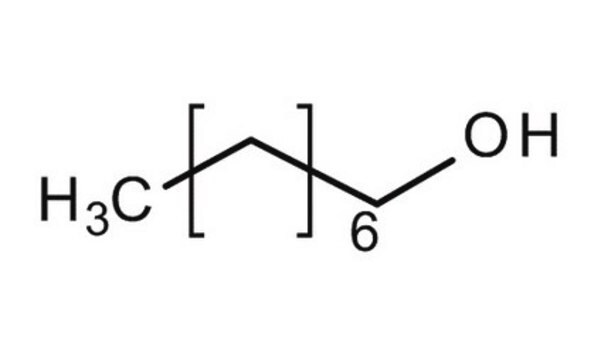112615
1-Octanol
ReagentPlus®, 99%
Sinónimos:
Alcohol C8, Capryl alcohol, Octyl alcohol
About This Item
Productos recomendados
densidad de vapor
4.5 (vs air)
Nivel de calidad
presión de vapor
0.14 mmHg ( 25 °C)
Línea del producto
ReagentPlus®
Análisis
99%
formulario
liquid
temp. de autoignición
523 °F
lim. expl.
8 %
impurezas
≤0.5% (water)
índice de refracción
n20/D 1.429 (lit.)
bp
196 °C (lit.)
mp
−15 °C (lit.)
densidad
0.827 g/mL at 25 °C (lit.)
cadena SMILES
CCCCCCCCO
InChI
1S/C8H18O/c1-2-3-4-5-6-7-8-9/h9H,2-8H2,1H3
Clave InChI
KBPLFHHGFOOTCA-UHFFFAOYSA-N
Información sobre el gen
mouse ... Chrna1(11435)
¿Está buscando productos similares? Visita Guía de comparación de productos
Descripción general
Aplicación
Acciones bioquímicas o fisiológicas
Información legal
Palabra de señalización
Warning
Frases de peligro
Consejos de prudencia
Clasificaciones de peligro
Aquatic Chronic 3 - Eye Irrit. 2
Código de clase de almacenamiento
10 - Combustible liquids
Clase de riesgo para el agua (WGK)
WGK 1
Punto de inflamabilidad (°F)
187.7 °F
Punto de inflamabilidad (°C)
86.5 °C
Certificados de análisis (COA)
Busque Certificados de análisis (COA) introduciendo el número de lote del producto. Los números de lote se encuentran en la etiqueta del producto después de las palabras «Lot» o «Batch»
¿Ya tiene este producto?
Encuentre la documentación para los productos que ha comprado recientemente en la Biblioteca de documentos.
Los clientes también vieron
Nuestro equipo de científicos tiene experiencia en todas las áreas de investigación: Ciencias de la vida, Ciencia de los materiales, Síntesis química, Cromatografía, Analítica y muchas otras.
Póngase en contacto con el Servicio técnico







